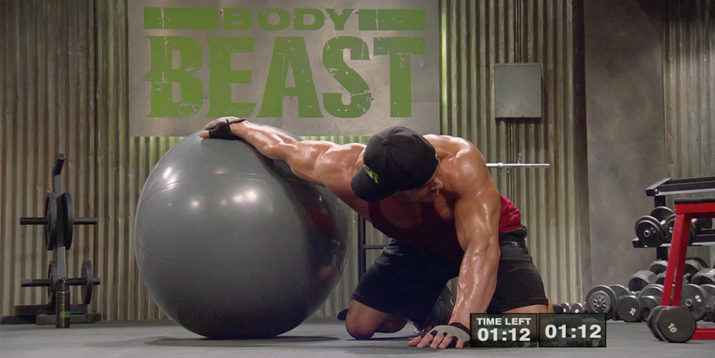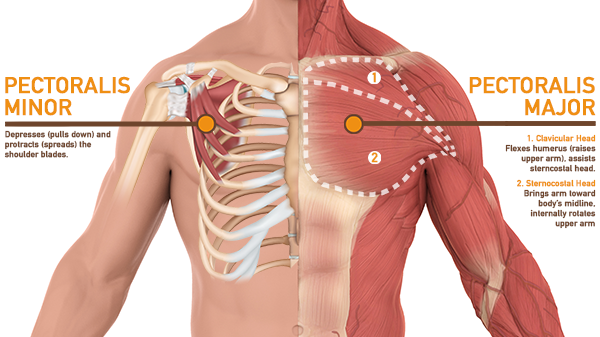5 Chest Stretches for Tight and Sore Pectorals

When I inquire with my yoga students about any tightness and/or pain they may be experiencing in their muscles, they often request chest stretches (a.k.a. chest openers). Tight pectorals, pain in the chest muscles, and sore pecs are common complaints, whether they’re active or sedentary.
“Sitting at a computer all day can cause an array of postural imbalances,” says Cody Braun, fitness expert at Beachbody, including rounded shoulders, and, over time, chronically overactive, tight chest muscles. So static chest stretches should be part of your cool-down routine.
“Tightness in the chest can contribute to altered movement of the shoulders, neck, and spine, and, subsequently, injuries,” says Ian Elwood, M.A., C.S.C.S. An open chest can also facilitate healthy, deep breathing, which is “an often overlooked aspect of movement and posture,” he says.
Read on to learn how to open your chest, why its anatomy impacts your breathing, and which are the best chest stretches to liberate tight muscles.
How to Stretch Your Chest Safely
Chest stretches should never hurt. If any stretch causes pain (versus tension), you’re doing it wrong or going too far.
To safely stretch the chest, “slow and steady wins,” says Elwood, owner of Mission MVMT. To help truly loosen chest muscles, be consistent — stretch daily or more often — for two minutes or longer per movement, he advises.
“Make sure you don’t apply too much opposing force when stretching your chest,” says Braun. “Over time, this muscle will loosen up without you having to force range of motion that isn’t there.” If your chest has been surgically augmented, “be cautious of how much tension you apply,” Braun says.
5 of the Best Chest Stretches for Tight Muscles
Here’s a step-by-step guide to some of our favorite stretches for the pecs — and how you can find them in Beachbody on Demand programs.
1. Hands-behind-the-back chest stretch
This simple but effective chest stretch also opens up the fronts of the shoulders to counteract the time we spend sitting.
Appears in: CORE DE FORCE – MMA Shred
- Stand tall with your feet hip-width apart and your hands at your sides.
- Keeping your chest lifted throughout the movement, interlace your fingers behind your back.
- Pull your shoulder blades down your back, and straighten your arms as you keep lifting your chest and gaze toward the ceiling.
- Hold for 15 seconds, then gently release the clasp of your hands.
2. Chest opener
Another simple chest opener, this stretch is effective and manageable even if your chest is inordinately tight.
Appears in: Body Beast – Tempo Chest/Tris
- Standing with your feet shoulder-width apart, place your right hand atop a bench or other stable object between waist and chest height.
- Straighten your arm, and slowly turn to the left until you feel the stretch in your chest without forcing it.
- Hold for a six-count, and repeat on the other side.
3. Stability ball chest stretch
This chest opener has you stretching at multiple points of articulation, as well as contracting and relaxing the muscles of the forearm, allowing you to loosen a range of tight areas.
Appears in: P90X2 – P.A.P. Upper
- Get on all fours, and extend your right arm straight out to your right — a.k.a. 3 o’clock position — placing your right palm on a stability ball.
- Lower your body slightly until you feel a stretch in the right side of your chest, then lift your right palm off the stability ball. Hold for 1 second.
- Lower your palm, and repeat the move two more times.
- Repeat the entire sequence with the ball at the 2 o’clock, and then 1 o’clock, positions.
- Switch sides and repeat the sequence at all three positions.
4, Camel pose
With several modifications available for this chest-opening yoga pose, you can find a variation that works for your current range of motion, and add on as flexibility improves.
Appears in: 3 Week Yoga Retreat – Week 3, Day 2 Stretch
How to do it:
- Kneel on the floor with your knees hip-width apart and your hands at your waist. Your toes can be tucked or the tops of your feet can be flat against the floor.
- Slowly reach back toward your left heel with your left hand, and follow with your right hand and heel. If this is too difficult, simply keep your hands on your lower back.
- Keeping your chest lifted, shoulders back, and core engaged, slowly push your hips forward, making sure to keep your chin down. If that still feels OK, you can slowly release your head backward.
- Hold for at least five breaths, and slowly reverse the move.
5. Bow pose
In addition to the chest, this intermediate yoga pose stretches the deep hip flexors, opening the entire front of the body.
Appears in: 21 Day Fix – Yoga Fix
- Lie face-down on the floor, with your hands beside your chest, and your feet shoulder-width apart.
- Keeping your shoulders back and core engaged, bend your knees, reach back, and grab the tops of your feet with your hands. Keep your legs as parallel as possible.
- Kick your feet into your palms and lift your chest, holding the stretch for at least five breaths.
- Slowly release your feet, and return to the starting position.
Why Do Chest Muscles Get Tight?
There are a number of factors that can contribute to chronically tight chest muscles, the most conspicuous being insufficient stretching and imbalanced workouts. The goal is to “keep these muscles pliable so that your body can move as it was intended,” says Braun, adding that tight pecs can “wreak havoc on your shoulder joints.”
While taut or rippling pecs may be your objective, overdoing it on chest day could be to blame if your chest muscles hurt. Beyond pressing exercises to work the chest, Elwood recommends pulling exercises, emphasizing the need for balance between your chest and back workouts. He also urges stretching the neck and shoulders.
Tight chest muscles (and upper traps) are also part of a common muscular imbalance called upper crossed syndrome, Elwood says. In this postural incongruity, one set of muscles — in this case those of the neck, upper trapezius, and pectoralis major — is overactive, while a complementary set of muscles — mid/lower traps, the rhomboids underneath them, and serratus anterior — is underactive, often leading to rounded shoulders.
The fix? “Shorten the long muscles and lengthen the short muscles” with chest stretches, Elwood says.
What to Do if You Pull a Muscle in Your Chest
If you think there’s any chance you have pulled a muscle or in any way injured your chest, do not exacerbate the issue by trying to stretch it out. Seek the advice of a physician if you experience anything more than routine tightness or soreness in your chest.
Anatomy of the Chest

The chest’s anatomy may explain why it gets sore and tight. There are two major muscles of the chest: the pectoralis major and pectoralis minor. The pec major — the one that we see — is on top, while the smaller pec minor lies underneath it.
Attaching at the humerus (upper arm), the pectoralis major’s primary job is to internally rotate and pull your arms toward your body’s midline. So a tight chest can adversely affect shoulder mobility.
Tight chest muscles may additionally cause discomfort in the sternum, another attachment point of the pectoralis major. When you open your chest by stretching the muscles or using self-myofascial release, you can find some relief from the tugging sensation on the breastbone.
The pectoralis minor, meanwhile, draws the shoulder blade down and forward, and it’s also used when we take shallow breaths instead of full ones from the diaphragm, according to Braun. “Not only does this keep you from gaining the full amount of oxygen that you should be inhaling, but this can also lead to the muscle becoming chronically tight,” he says, adding that postural imbalances may be the cause or effect of chest breathing.
The Takeaway
For a chest that’s healthy, supple, and strong, include static stretches in every cool-down. And be sure your workouts are balanced, with movements that target the opposing muscles of the back.
A tight chest can impact healthy breathing and cause rounded shoulders, poor posture, and impaired movement. Regular stretching can help open your chest and alleviate soreness from tight pecs.
